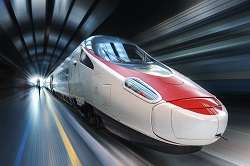Lightweight materials provide opportunities for the next generation of railway vehicles

The transportation industry has for a long time been engaged in the application of new lightweight materials for primary structural design. In aeronautics, where the weight of an aircraft is a crucial factor for fuel consumption, composite materials are now replacing metallic materials in both structural and non-structural parts.
The railway industry could also benefit from the use of structural new materials. If a train's car body is made of composite materials, the train's weight would be reduced by 20 to 30 %. These weight savings would result in lower energy consumption and a reduction of at least 5 % of CO2 emissions.
Regulatory limitations
Current European legislation does not allow train manufacturers to use composite materials when constructing train car bodies. The railway sector currently only uses composites for non-bearing structural components, with steel being most commonly used to construct a train's car body.
One of the key obstacles to overcome has been the lack of suitable certification procedures addressing the specific operational requirements of a railway vehicle. The EU-funded REFRESCO project was set up to provide solutions to this and other obstacles, and pave the way for the adaption of new procedures that will allow for the use of composite materials in rail car manufacturing.
Benchmarking materials
REFRESCO has benchmarked the most promising new materials being used both within and outside the transport sector and which could be integrated into railway rolling stock.
After an analysis of certification processes and standards applicable to rail vehicle car bodies, the project found that the current European railway certification process gives opportunities for innovative solutions. However, the set of technical standards needed to prove compliance for composite car bodies is not yet in place and thus has to be developed further.
Following a gap analysis, REFRESCO concluded that even if some standards need adaptation for composites material behaviour, most can be applied to a composite car body shell without jeopardising safety.
Structural considerations
When studying the practical structural requirements for the adoption of composite materials, the project focused on subjects such as strength, crash and fire resistance, noise and vibration, electromagnetic compatibility and maintainability.
The project studied the crashworthiness of composite materials in detail due to strict safety requirements. Composite materials behave differently from materials such as steel or aluminium, being more brittle and orthotropic, raising the question of the strength of a body-shell structure built from composite materials when a collision occurs.
Reference crash simulations were performed on current metallic designs to observe their behaviour and confirm current safety behaviour. Composite materials were integrated into a cabin structure shell, with initial results showing some cracking. However, the project saw that by reinforcing the composite structure or extending the surrounding metallic interfaces, it is possible to pass the collision scenario test.
The project also concluded that maintenance processes would also have to be modified if composite materials are introduced. Not only would maintenance buildings have to be equipped to service them, but railway technicians would have to be trained to be able to work with composites.
Next steps
Currently, the prices of composites are higher than of steel constructions, but this is expected to change, as the automotive industry has been increasingly using them. The production of raw materials for composites is also increasing, that will probably lower their price further.
Although the REFRESCO project officially ended in February 2016, the project partners aim to utilise its results to work with regulators to update certification procedures, allowing the rail industry to take advantage of these promising lightweight materials.
More information: For more information please see the REFRESCO project website: www.refresco-project.eu/
Provided by CORDIS





















